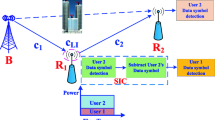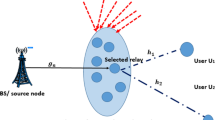Abstract
In this work, a novel resource allocation scheme is proposed to find the optimal time-switching and power-splitting factors in a SWIPT assisted non-orthogonal multiple access (NOMA) relay network with combined time switching and power splitting protocol. The system model consists of a source node broadcasting a multiplexed NOMA signal to the far and near user via an amplify-and-forward energy harvesting relay node in a Rayleigh-flat-fading channel environment. Here, effective SNR maximization at both the near and far users is formulated as an optimization problem under total transmit power constraint and to deal with this both the Lagrangian multiplier approach and differential-evolution algorithm have been exploited. Furthermore, performance study is presented about the comparison of proposed scheme with the fixed allocation scheme in terms of outage probability under the impact of distinct target rates, relay locations, and channel conditions. Finally, the simulation results signify the performance improvement in the system with the optimal values obtained from the proposed scheme over the fixed time and power splitting factors.








Similar content being viewed by others
Abbreviations
- NOMA:
-
Non-orthogonal multiple access
- SWIPT:
-
Simultaneous wireless information and power transfer
- AF:
-
Amplify-and-forward
- CTSPS:
-
Combined time switching and power splitting
- DF:
-
Decode-and-forward
- SIC:
-
Successive interference cancellation
- EH:
-
Energy harvesting
- DE:
-
Differential-evolution
- RF:
-
Radio frequency
- SNR:
-
Signal-to-noise ratio
- AWGN:
-
Additive-white-Gaussian-noise
- PS:
-
Power-splitting
- TS:
-
Time-switching
References
Dai, L., Wang, B., Yuan, Y., Han, S., Chih-Lin, I., & Wang, Z. (2015). Nonorthogonal multiple access for 5G: Solutions, challenges, opportunities, and future research trends. IEEE Communications Magazine, 53(9), 74–81.
Ding, Z., Lei, X., Karagiannidis, G. K., Schober, R., Yuan, J., & Bhargava, V. K. (2017). A survey on non-orthogonal multiple access for 5G networks: Research challenges and future trends. IEEE Journal on Selected Areas in Communications, 35(10), 2181–2195.
Xiao, Y., et al. (2018). Forwarding strategy selection in dual-hop NOMA relaying systems. IEEE Communications Letters, 22(8), 1644–1647.
Gurrala, K. K., & Das, S. (2016). Maximized channel capacity based power allocation technique for multi relay hybrid decode-amplify-forward cooperative network. Wireless Personal Communications, 87, 663–678. https://doi.org/10.1007/s11277-015-2622-9.
Wei, Z., Yuan, J., Ng, D. W. K., Elkashlan, M., & Ding, Z. (2016). A survey of downlink non-orthogonal multiple access for 5G wireless communication networks. ZTE Communications, 14(4), 17–26.
Zhang, L., Liu, J., Xiao, M., Wu, G., Liang, Y.-C., & Li, S. (2017). Performance analysis and optimization in downlink NOMA systems with cooperative full-duplex relaying. IEEE Journal on Selected Areas in Communications, 35(10), 2398–2412.
Wang, S., Cao, S., & Ruby, R. (2018). Optimal power allocation in NOMA-based two-path successive AF relay systems. EURASIP Journal on Wireless Communications and Networking, 2018, 273.
Nasir, A. A., Zhou, X., Durrani, S., & Kennedy, R. A. (2013). Relaying protocols for wireless energy harvesting and information processing. IEEE Transactions on Wireless Communications, 12(7), 3622–3636.
Huang, G., Zhang, Q., & Qin, J. (2015). Joint time switching and power allocation for multicarrier decode-and-forward relay networks with SWIPT. IEEE Signal Processing Letters, 22(12), 2284–2288.
Fang, F., Zhang, H., Cheng, J., & Leung, V. C. M. (2016). Energy-efficient resource allocation for downlink non-orthogonal multiple access network. IEEE Transactions on Communications, 64(9), 3722–3732.
Nguyen, T.-L., & Do, D.-T. (2018). Power allocation schemes for wireless powered NOMA systems with imperfect CSI: An application in multiple antenna-based relay. International Journal of Communication Systems, 31(15), 1–17.
Hoang, T. M., Tan, N. T., Hoang, N. H., & Hiep, P. T. (2019). Performance analysis of decode-and-forward partial relay selection in NOMA systems with RF energy harvesting. Wireless Networks, 25(8), 4585–4595.
Do, D.-T., & Le, C.-B. (2018). Application of NOMA in wireless system with wireless power transfer scheme: Outage and ergodic capacity performance analysis. Sensors, 18(10), 3501.
Do, D.-T., & Le, C.-B. (2019). Impact of fixed power allocation in wireless energy harvesting NOMA network. International Journal of Communication Systems, 32(14), e4016.
Yang, Z., Ding, Z., Fan, P., & Al-Dhahir, N. (2017). The impact of power allocation on cooperative non-orthogonal multiple access networks with SWIPT. IEEE Transactions on Wireless Communications, 16(7), 4332–4343.
Ye, Y., Li, Y., Wang, D., & Lu, G. (2017). Power splitting protocol design for the cooperative NOMA with SWIPT. In Proceedings of IEEE international conference on communications (pp. 1–5).
Zhang, Z., Qu, H., Zhao, J., Wang, W., & Wang, S. (2019). Fairness based power allocation optimization of cooperative noma with swipt network. In IEEE 4th international conference on signal and image processing (ICSIP) (pp. 555–560).
Tran, H. Q., Phan, C. V., & Vien, Q.-T. (2020). Power splitting versus time switching based cooperative relaying protocols for SWIPT in NOMA systems. Physical Communication, 41, 1–15.
Andrawes, A., Norden, R., & Abdullah, N. F. (2019). Energy-efficient downlink for non-orthogonal multiple access with SWIPT under constrained throughput. Energies, 13(1), 1–19.
Garcia, C. E., Tuan, P. V., Camana, M. R., & Koo, I. (2020). Optimized power allocation for a cooperative NOMA system with SWIPT and an energy-harvesting user. International Journal of Electronics, 107(10), 1704–1733.
Reshma, K., & Babu, A. V. (2020). Throughput analysis of energy harvesting enabled incremental relaying NOMA system. IEEE Communications Letters, 24(7), 1419–1423.
Everett, H. (1963). Generalized Lagrange multiplier method for solving problems of optimum allocation of resources. Operational Research, 11, 399–417.
Qin, A. K., & Suganthan, P. N. (2005). Self-adaptive differential evolution algorithm for numerical optimization. In Proceedings of IEEE congress on evolutionary computation (pp. 1785–1791).
Author information
Authors and Affiliations
Corresponding author
Additional information
Publisher's Note
Springer Nature remains neutral with regard to jurisdictional claims in published maps and institutional affiliations.
Appendix
Appendix
Derivation to acquire the optimal power allocation coefficients \(a_{1} , \, a_{2}\) of NOMA users using Lagrange method.
Solution to get the power allocation fractions \(a_{1} , \, a_{2}\) with regard to D1 can be derived as follows:
The Lagrange function (J) can be formulated as
where
By substituting \(\gamma_{{sr_{1} }}\) and \(\gamma {}_{rd1}\) in “(27)”, the effective SNR obtained as
where ‘λ’ is the Lagrangian multiplier.
By solving \(\frac{dJ}{{da_{1} }} = 0 \, and \, \frac{dJ}{{da_{2} }} = 0\)
Finally, the power allocation factor for D1 can be expressed as
where \(Z_{1} = \frac{{2.N_{0} }}{{P_{s} |h_{sr} |^{2} }} + \frac{{N_{0}^{2} }}{{P_{s} P_{r} |h_{sr} |^{2} |h_{rd} |^{2} }} + \frac{{N_{0} }}{{P_{r} |h_{rd} |^{2} }}\); \(z_{2} = \frac{{2.N_{0} }}{{P_{s} |h_{sr} |^{2} }} + \frac{{N_{0} }}{{P_{r} |h_{rd} |^{2} }} + \frac{{N_{0}^{2} }}{{P_{s} P_{r} |h_{sr} |^{2} |h_{rd} |^{2} }}\).
Similarly, by solving \(\frac{\partial J}{{\partial a_{1} }} = 0\)
Finally, the power allocation factor for near user (D2) is given by
Optimal values of \(a_{1} , \, a_{2}\) can be formulated as
Rights and permissions
About this article
Cite this article
Nayak, V.N., Gurrala, K.K. A Novel Resource Allocation for SWIPT-NOMA Enabled AF Relay Based Cooperative Network. Wireless Pers Commun 118, 2699–2716 (2021). https://doi.org/10.1007/s11277-021-08150-7
Accepted:
Published:
Issue Date:
DOI: https://doi.org/10.1007/s11277-021-08150-7




